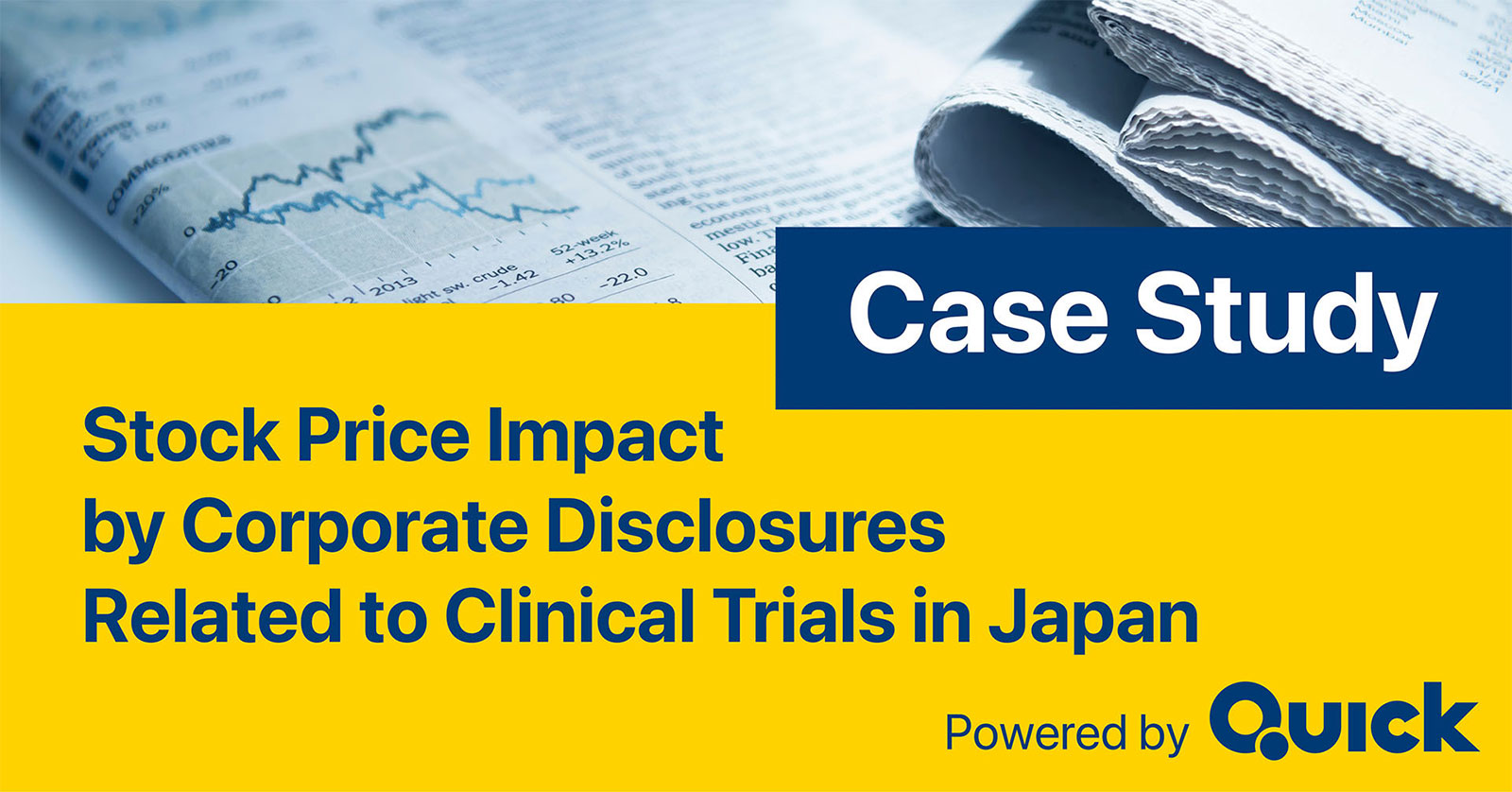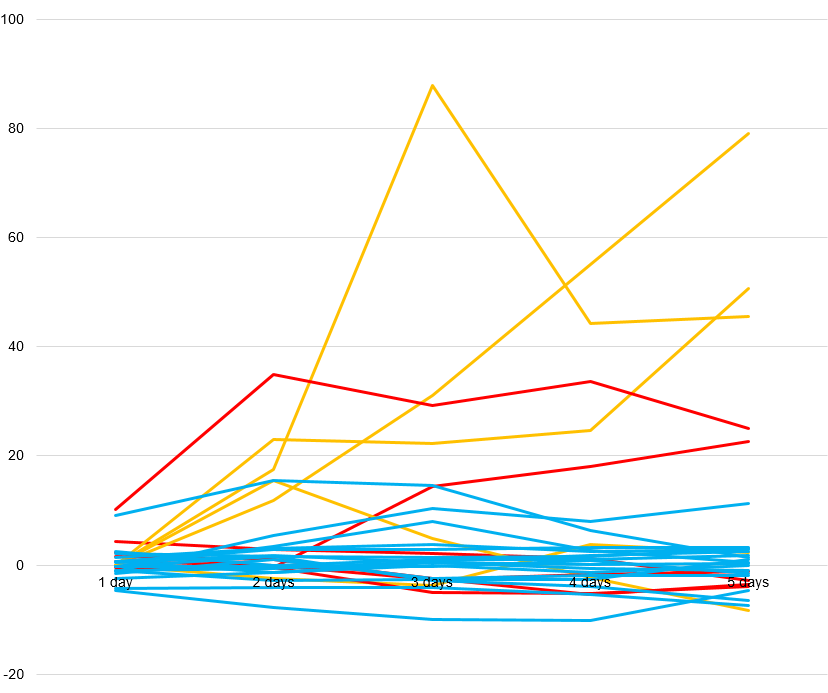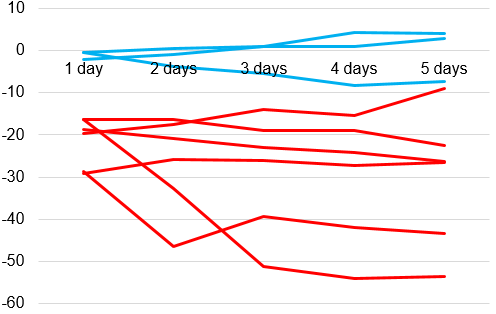- Alternative Data
- Market Data Approach
Impact of News on Stock Price Fluctuations and Evaluation of Investment Performance

QUICK distributes data disclosed by listed Japanese companies on EDINET and TDnet as a news format. . F-index, a data analysis consulting service provider in Japan, has conducted a verification study using such data.
Introduction
After distribution, a news story can influence the price of a stock that is associated with it. In order to predict the impact of news on share prices with a high degree of certainty, it is necessary to assess matters comprehensively through the following steps.
1. Read and understand the content of the news in question.
2. Organize stock-specific background information.
3. Confirm market conditions.
It is difficult even for analysts highly familiar with a given stock to immediately perform this series of steps.
For a related verification study, we constructed a model of next-business-day fluctuations in the prices of pharmaceutical sector stocks, focusing on news reporting either the success or the failure of clinical trials. After generalizing the above set of predicting procedures, we used the statistical model to automatically identify news impact labelling. Following this, we examined how well the news impact labeling results explained the subsequent stock price performance.
Scope of verification
The scope of this verification study is as follows:
Period: January 1, 2020 through August 31, 2022
Stocks: Pharmaceutical sector
News content: Success or failure of clinical trials
The most appropriate explanatory variables applied to the statistical model were selected from among the types of information listed below to model the magnitude of stock price fluctuations on business days following the publication of targeted news. Necessary information such as the phase of a given clinical trial was extracted from news content and used in the prediction process.
Stock-specific background information: market capitalization, listed section name, stock price (daily change rate, 5-day moving average divergence rate, 25-day moving average divergence rate), trading value (preceding day, 5-day moving average, 25-day moving average), trading volume (preceding day, 5-day moving average, 25-day moving average), outstanding sales on margin (negotiable), outstanding sales on margin (standardized), outstanding purchases on margin (negotiable), and outstanding purchases on margin (standardized)
Market information: Daily change rate, 5-day moving average divergence rate, and 25-day moving average divergence rate for each index
*Target indexes: NASDAQ, S&P500, TOPIX, TOPIX-17 Pharmaceutical, TSE Second Section Index, JASDAQ INDEX, TSE Mothers Index, TSE Prime Market Index, TSE Standard Market Index, and TSE Growth Market Index
Impact of Clinical Trial Success News on Investment Performance
In order to ensure consistency in conditions for evaluation of the impact of news on stock prices, this verification study covered news announced between market close on a given day and market open on the next business day. Accordingly, there were 28 news stories of successful clinical trials announced by companies in the pharmaceutical sector during the period covered by the validation study. A simple statistical model was used to predict stock price fluctuations on the business day immediately after such a news story was released, taking into account the number of news items to be analyzed. Each news story was labeled as "high impact" or "low impact" based on the predictions generated through our model.
Assuming that shares were purchased at market open on the first business day after the relevant news had been released, investment performance was evaluated over two different investment periods: "One day" (i.e., buying the shares at market open and selling them at market close on the next business day) and "One week" (i.e., buying the shares at market open on the business day following a related news release and selling them at market close one week later). The following investment performance indicators were calculated: (1) Expected return (average of returns), (2) Risk (standard deviation of returns), and (3) Expected return per unit of risk ((1) divided by (2)). Next, the active returns were calculated using TOPIX as a benchmark in the same way.
Based on the results of verification using the stock price volatility model, 11 news stories were labeled as high impact and 17 were labeled as low impact. Table 1 summarizes the returns by investment period for each type of news impact labeling. In addition, Figure 1 illustrates one-week return trends. In the event a stock hits limit up on the business day after a related news release without being traded, it is likely that the stock will not be available for purchase on that day. For this reason, the performances were also summarized separately, excluding news reporting limit up occurrences on the next business day.
Both in terms of normal and active returns, better investment performance was confirmed when stocks were associated with news labeled as high impact as opposed to low impact. Even with the exclusion of news about a limit up on the next business day, a return of about 6% could be expected for one-week periods.
Table 1: Investment Performance by Stock Price Fluctuation Impact Labeling of Clinical Trial Success News

Figure 1: Trends in Return by Stock Price Fluctuation Impact Labeling of Clinical Trial Success News

*High impact (red line), high impact with limit up occurring on the next business day (yellow line), and low impact (blue line)
Stock Price Fluctuation after the Release of Clinical Trial Failure News
Similarly, we constructed a model of next-business-day stock fluctuations focusing on news reporting clinical trial failures. Using the predictions resulting with the use of this model, 6 news stories were labeled as high impact and 3 news stories were labeled as low impact. For the news of clinical trial failure, the results of the labeling were evaluated not in terms of investment performance, but rather by visually checking the stock price change after the news had been made public. Figure 2 shows trends in returns based on closing prices on the news dissemination date (or the previous business day if the news was released just before market open). Prices of stocks tied to news labeled as high impact fell more than 10% on the business day following related news release, and they continued to fall or remained mostly flat thereafter. This suggests that it would be better to hold off buying stocks associated with news labelled as high impact for at least a week. On the other hand, shares related to the news labelled as low impact did not exhibit much fluctuation in prices.
Figure 2: Trends in Share Prices after Release of News on Clinical Trial Failure by Stock Price Fluctuation Impact Labeling

*High impact (red line) and low impact (blue line)
Conclusion
This verification study modeled stock price fluctuations on the business day following the release of related news, taking into account news content as well as stock-specific background information and market conditions. News stories were labeled based on the results of our modeling. It was confirmed that desirable performance could be achieved by following an investment strategy utilizing such labeling when the relevant news stories concern successful clinical trials. Regarding news on failed clinical trials, it was demonstrated that associated stock price fell by more than 10% on the next business day, and continued to fall or remained almost flat thereafter. It was confirmed that it would be better to hold off buying such stocks for a while, rather than to consider their price declines as opportunities for bargain buying.
In general, it takes a great deal of effort just to read the news. Moreover, without comprehensive judgment that employs stock-specific background information and market conditions, it is extremely difficult to accurately predict stock price fluctuations on the next business day. In this verification study, we tested the automation of a series of prediction procedures tied to news of clinical trial success/failure, using content that was relatively easy to understand. As a result, we obtained relatively positive outcomes. It would be interesting to expand the scope of this scheme and examine how it would work with news having different content.
QUICK's Company Disclosure Materials service analyzes the content disclosed on EDINET and TDnet and provides results via API as tag information such as stock code, company name, and the like.
Company Disclosure Materials (TDnet/ EDINET) on QUICK Data Factory
https://corporate.quick.co.jp/data-factory/en/product/data011/
QUICK

Since its founding in 1971, QUICK has become Japan's largest financial information vendor, and has developed an information infrastructure that supports Japan's securities and financial markets. It delivers high-value global market information from a fair and impartial perspective to a wide range of customers including securities firms, banks, institutional investors and corporations.
See More
